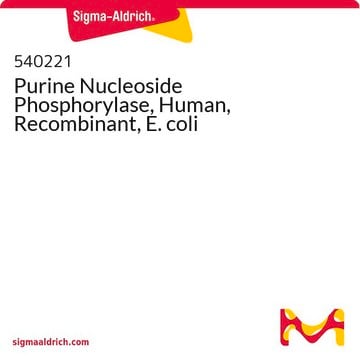SRP0218
TC-PTP Active human
recombinant, expressed in E. coli, ≥90% (SDS-PAGE)
Synonym(s):
PTPN2, T-cell protein-tyrosine phosphatase, TC-PTP
Sign Into View Organizational & Contract Pricing
All Photos(1)
About This Item
UNSPSC Code:
12352200
NACRES:
NA.32
Recommended Products
biological source
human
recombinant
expressed in E. coli
assay
≥90% (SDS-PAGE)
form
aqueous solution
mol wt
62.3 kDa
packaging
pkg of 20 μg
storage condition
avoid repeated freeze/thaw cycles
concentration
2.9 mg/mL
NCBI accession no.
UniProt accession no.
shipped in
dry ice
storage temp.
−70°C
Gene Information
human ... PTPN2(5771)
General description
Protein tyrosine phosphatase, Catalytic domain, (amino acids 2-315), (Gene bank accession number BC016727) with N-terminal GST tag, MW = 62.3 kDa, expressed in an E. coli expression system.
Application
Useful for the study of enzyme kinetics, regulation, to dephosphorylate target substrates and for screening inhibitors.
Unit Definition
One unit will hydrolyze 1 nmol p-nitrophenyl phosphate per minute at pH 7.4 and 30°C.
Physical form
Formulated in 25 mM Tris-HCl, pH 8.0, 75 mM NaCl, 0.05% Tween-20, 50% glycerol, 2 mM EDTA, 1 mM DTT, and 10 mM glutathione.
Preparation Note
Thaw on ice. Upon first thaw, briefly spin tube containing enzyme to recover full content of the tube. Aliquot enzyme into single use aliquots. Store remaining undiluted enzyme in aliquots at -70°C. Note: Enzyme is very sensitive to freeze/thaw cycles.
Storage Class
10 - Combustible liquids
wgk_germany
WGK 1
flash_point_f
Not applicable
flash_point_c
Not applicable
Certificates of Analysis (COA)
Search for Certificates of Analysis (COA) by entering the products Lot/Batch Number. Lot and Batch Numbers can be found on a product’s label following the words ‘Lot’ or ‘Batch’.
Already Own This Product?
Find documentation for the products that you have recently purchased in the Document Library.
Jiao Luo et al.
British journal of pharmacology, 177(19), 4464-4480 (2020-07-15)
Protein tyrosine phosphatase (PTP) 1B (PTP1B) plays a critical role in the regulation of obesity, Type 2 diabetes mellitus and other metabolic diseases. However, drug candidates exhibiting PTP1B selectivity and oral bioavailability are currently lacking. Here, the enzyme inhibitory characteristics
Our team of scientists has experience in all areas of research including Life Science, Material Science, Chemical Synthesis, Chromatography, Analytical and many others.
Contact Technical Service





